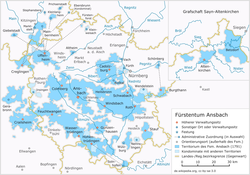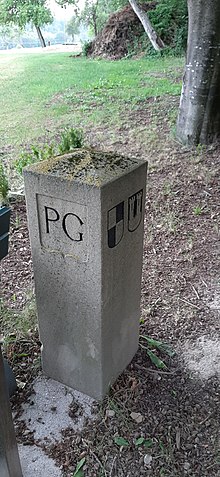Principality of Ansbach
|
Territory in the Holy Roman Empire |
|
|---|---|
| Ansbach | |
| coat of arms | |

|
|
| map | |

|
|
| Form of rule | principality |
| Ruler / government | Margrave |
| Today's region / s |
DE-BY
|
| Reichskreis | Franconian Empire |
| Capitals / residences | Ansbach |
| Denomination / Religions | Roman Catholic until 1525, since then Lutheran |
| Language / n |
German
|
| Incorporated into |
Kingdom of Bavaria (1806)
|
The Principality of Ansbach or the Margraviate of Brandenburg-Ansbach was a direct imperial territory of the Holy Roman Empire in the Franconian Empire , which was ruled by branch lines of the House of Hohenzollern .
history
Origin and historical development

The Principality of Ansbach developed from the lower mountainous part of the Burgraviate of Nuremberg . Together with the Upper Mountain part of the burgraviate, it formed the Franconian ancestral lands of the Hohenzollern. After the Hohenzollern 1415/1417 with Burgrave Friedrich VI. of Nuremberg had come into the hereditary possession of the Mark Brandenburg , they used the newly acquired title of Margrave over time in their previous Franconian possessions. With the sale of the Nuremberg Burggrafenburg to the imperial city of Nuremberg in 1427, the burgravial chapter in the history of the Hohenzollern came to an end. For their Franconian territories, the designation margravate became commonplace, or in the course of later (initially only temporary) divisions of the country then margravate. The final separation into two independent territories finally took place in 1486 after the death of Margrave Albrecht Achilles . According to the Dispositio Achillea issued by Albrecht in 1473 , the Hohenzollern territory in Franconia was divided between his two younger sons. The allocation of the two parts of the country was decided by drawing lots. Frederick II fell to the later Principality of Ansbach with the lower mountainous country, while his brother Siegmund received the later Principality of Kulmbach with the second part of the country .
Margrave Georg the Pious (also called George the Confessor) introduced Protestantism in his areas as an early follower of Martin Luther . 1525 can serve as the symbolic year in this regard, because on April 9th d. J. in Ansbach the first service in German and with the Lord's Supper in both forms was celebrated. The theological reports initiated by the margrave, later also called Franconian Confessions , are regarded as the preliminary stage of the Confessio Augustana of 1530, which was received worldwide. George the Pious was present at the Augsburg Diet of 1530 and thus became one of the first signatories of the Confessio Augustana.
Between 1398 and 1400, Friedrich I of Brandenburg had a monastery courtyard converted into a moated castle , the remains of which can still be seen in the current building of the Ansbach residence . A Renaissance residence was built under Margrave Georg Friedrich I , and from 1694 onwards it was converted into a baroque palace, which was completed in 1738 and the interior of which took place in the following years.
The Peace of Teschen was signed on May 13, 1779 in Teschen between Austria and the Kingdom of Prussia and ended the War of the Bavarian Succession . Among other things, the provisions stipulated that Austria received from Bavaria the areas of the Burghausen Rent Office located east of the Inn and Salzach - i.e. an area strip from Passau to the northern border of the Archbishopric of Salzburg . In return, Prussia's claims to the two Hohenzollern margravates of the Principality of Brandenburg-Ansbach and Brandenburg-Bayreuth were recognized (Articles 10 and 11, primogeniture and merging in the event of settlement, treatment of associated fiefs in Bohemian areas).
The Principality of Ansbach was ruled several times in personal union with the Principality of Kulmbach (or Bayreuth since 1604) (1495–1515, 1557–1603 and 1769–1791), but it remained an independent territory under constitutional law until the end of the old empire . With the Principality of Bayreuth, it was annexed to the Prussian state in 1791/92 and jointly administered as Ansbach-Bayreuth initially by Karl August von Hardenberg . On June 9, 1791, Margrave Karl Alexander, he was already out of the country, gave Hardenberg full sovereign power, and on December 2, the abdication patent was signed in Bordeaux . On January 15, 1792, the Berlin cabinet ministry instructed Hardenberg to publish the change of government by publishing the abdication patent, as well as to make known the patent in office of Friedrich Wilhelm II dated January 5 .
The minister in charge, Karl August Freiherr von Hardenberg (he had been in an advisory capacity in Ansbach since 1790) tried to first amicably and contractually consolidate the area in the Franconian knight circle (territorium non clausum) by buying up lords, but this only partially succeeded. He increased the pressure on the territories of the imperial knighthood through selective interventions and military actions, which were largely contrary to imperial law and the legal status of imperial knights . This idea of a comprehensive contractual compensation for the creation of a closed national territory had already failed in March 1793, which insisted on an unbridgeable gap in the constitutional and political views of the power state-oriented Prussian monarchy and the imperial knights.
In a questionable way, Hardenberg drew the state sovereignty from the exercised blood jurisdiction ("Fraisch") (this claim was in part a point of contention with other rulers for centuries, for example with the imperial city of Nuremberg or the diocese of Eichstätt ) and derived the complete sovereign rights from it . Against the increasing attacks in the area of the "policey" as well as the military and tax systems, the knights sought support from the Franconian district and the imperial court, which initially limited itself to diplomatic initiatives. Apart from protests and complaints in Vienna and the notices there, including execution orders, nothing could be obtained in this way, let alone enforce these execution orders. Finally, towards the end of 1795 , the Reichshofrat, called on by the canton of Altmühl , issued two mandates in favor of the knighthood, ignored by Prussia, with the execution of which Bamberg and Saxe-Gotha were entrusted, and the protest notes in Berlin that several electors received under pressure from the Hofburg in Vienna were equally unimpressive addressed to the king.
For example, almost all files in the archives and registry of the canton Altmühl were seized by an attack on November 22, 1796 by a government commission from Ansbach and taken to Ansbach in order to deprive the imperial knights of important documents for the conduct of the litigation. Soldiers were also deployed here. This had been preceded by Prussian patent applications in the knightly lordships and imperial cities bordering Ansbach-Bayreuth (for example in the area in front of the city walls in Dinkelsbühl and Nuremberg ) in February and March 1792. In 1798 the size of the Franconian knight circle had decreased by about a quarter to a third. The canton of Altmühl, which had been almost completely mediated, was particularly affected.
In the Treaty of Schönbrunn of December 15, 1805, Prussia had to surrender the Principality of Ansbach-Bayreuth to France in exchange for the Electorate of Hanover ; on January 1, 1806, its part in Ansbach came to the new Kingdom of Bavaria .
The Margraves of Brandenburg-Ansbach
| Margrave | from | to | Remarks | image |
|---|---|---|---|---|
| Friedrich I. | 1398 | 1440 | as Friedrich VI. he is still one of the burgraves of Nuremberg . With the sale of Nuremberg Castle in 1427, the line of the burgraves ends with him. As Friedrich I, he was the first Elector of Brandenburg (1415-1440). After the division of the estate, he received the “lower-bourgeois” principality of Ansbach, also called the “Netherlands”, from his father, the burgrave Friedrich V of Nuremberg , in 1398, and after the death of his older brother Johann III. also known as the “Obergebürgische” Principality of Kulmbach , “Oberland” (1420–1440). The term "Gebürge" refers to the Muggendorfer Mountains , the then common name of Franconian Switzerland . Since 1415 he was also awarded the dignity of Elector of Brandenburg . |

|
| Albrecht I Achilles | 1440 | 1486 | Albrecht Achilles, as Margrave of Ansbach, took over the Principality of Kulmbach after the death of his brother Johann the Alchemist , who died without male heirs . When his eldest brother Friedrich der Eiserne abdicated as Elector of Brandenburg in 1470 , he succeeded him and thus united the entire property of the Hohenzollern family in one hand. |

|
| Friedrich II. | 1486 | 1515 | Friedrich II was the second son of Albrecht Achilles . After the death of his brother Siegmund, he also took over the Principality of Kulmbach . Because of his lavish lifestyle, he was deposed by his sons in 1515 and imprisoned at the Plassenburg for 13 years . |

|
| George the Pious | 1515 | 1543 | George the Pious was a son of Friedrich II. Together with his brother Casimir, he ousted his father in 1515. George the Pious took over the Principality of Ansbach, but let his brother administer it in his absence. When he died, he took over the affairs of government in the Principality of Kulmbach for Kasimir's underage son Albrecht Alcibiades until he came of age . George the Pious was one of the signatories of the Confessio Augustana , which was handed over to Emperor Charles V on June 25, 1530 at the Reichstag in Augsburg . |

|
| Georg Friedrich I. | 1543 | 1603 | As the only son of George the Pious , Georg Friedrich I was Margrave of Ansbach from 1543 and followed Albrecht Alcibiades as Margrave of Kulmbach in 1557 . For the increasingly depressed Prussian Duke Albrecht Friedrich , he took over the guardianship as his closest relative in 1577. Georg Friedrich I managed to consolidate the financial system. Franconian civil servants who were seen as exemplary were sent to Prussia to implement appropriate reforms there. With Georg Friedrich I. the older line of the Franconian Hohenzollern died out. |

|
| Joachim Ernst | 1603 | 1625 | After the older Franconian line of the Hohenzollern had died out, the two principalities were again divided, this time between the two younger sons of Elector Johann Georg . While Christian took over the Principality of Kulmbach and relocated the seat of government to Bayreuth , Joachim Ernst received the Principality of Ansbach. |

|
| Friedrich III. | 1625 | 1634 | Friedrich III. followed his father Joachim Ernst . Until he came of age, however, his mother Sophie von Solms-Laubach ran the business. In 1634, when he came of age, he fell on the side of the Swedes in the Thirty Years' War in the battle of Nördlingen . | |
| Albrecht II. | 1634 | 1667 | Albrecht II was another son of Joachim Ernst . Until he came of age in 1639, his mother Sophie von Solms-Laubach was again the regent of the principality. |

|
| Johann Friedrich | 1667 | 1686 | A guardianship government was established for Johann Friedrich as the late-born first son of Albrecht II from his second marriage until he came of age in 1672 . |

|
| Christian Albrecht | 1686 | 1692 | A guardianship government was again installed for Christian Albrecht, the young son of Johann Friedrich . He died before he came of age. | |
| Georg Friedrich II. | 1692 | 1703 | Georg Friedrich the Younger followed as the brother of Christian Albrecht as Margrave. A guardianship government was also set up until he came of age. In the Palatinate War of Succession he fought as a volunteer in the Imperial Army and finally fell in the Battle of Schmidmühlen in the War of the Spanish Succession . He left no offspring. |

|
| Wilhelm Friedrich | 1703 | 1723 | Wilhelm Friedrich was the youngest son of Johann Friedrich . Since he was born in the second marriage of the father to Eleonore von Sachsen-Eisenach , he was a half-brother of the two previous margraves. In 1710 he founded the Ansbach faience manufacture . |

|
| Karl Wilhelm Friedrich | 1723 | 1757 | Karl Wilhelm Friedrich, called the Wild Margrave , followed as the only son of Wilhelm Friedrich . His mother Christiane Charlotte von Württemberg took over the regency until he came of age . He ruled as an absolutist ruler with a magnificent court and pursued his passion for hunting excessively, leaving his son with an enormous debt as his successor. His diverse construction activities include the renovation of the Ansbach Castle , the construction of two castle buildings in Gunzenhausen and the expansion of the St. Gumbertus Church in Ansbach in the margrave style . |

|
| Christian Friedrich Karl Alexander | 1757 | 1791 | Christian Friedrich Karl Alexander was the son of Karl Wilhelm Friedrich . After the younger line of the Bayreuth margraves had expired with the death of Friedrich Christian , the two principalities of Bayreuth and Ansbach came together again in a personal union for the first time after 1603 , in accordance with the Hohenzollern house and imperial laws. In a secret contract in 1791, Karl Alexander ceded the two principalities to Prussia , which would have inherited the childless prince anyway after his death. In return, he received a lifelong pension. As a widower he married Elizabeth Craven and went with her as a private citizen to England, where he devoted himself to horse breeding until he was old. |

|
geography
Topography and territorial existence
The natural conditions of the territory offered favorable conditions for intensive agriculture: The soil was in large parts very fertile and allowed for rich harvests. The principality was therefore considered a rich agricultural country, from which the population of the country could also benefit to a certain extent.
After the border to the neighboring lowlands of the Principality of Kulmbach (the area around Erlangen and Neustadt ad Aisch ) was finally determined with the Regensburg partition agreement in 1541 , there were no more profound changes to the territorial existence of the Principality until the end of independence. Only with the county of Sayn-Altenkirchen in the Westerwald , which was inherited in 1741 , there was another larger area increase.
Administrative structure
The upper administrative level of the Principality of Ansbach consisted of a total of 15 administrative areas in the middle of the 18th century (excluding the County of Sayn-Altenkirchen):
- Hofkastenamt Ansbach
- Oberamt Burgthann
- Cadolzburg District Office
- Oberamt Colmberg
- Oberamt Crailsheim
- Oberamt Creglingen with Oberschultheissenamt Marktsteft
- Oberamt Feuchtwangen
- Gunzenhausen District Office
- Oberamt Hohentrüdingen
- Oberamt Roth
- Oberamt Schwabach
- Oberamt Stauf
- Oberamt Uffenheim
- Oberamt Wassertrüdingen
- Oberamt Windsbach
Subordinate to the upper administrative level were about 60 bailiffs, judges and city bailiffs, as well as the administrations of the monasteries that were closed in the course of the Reformation.
With a patent dated July 3, 1795, administration and justice were separated. The administration has now been divided into 6 districts. With a patent dated November 19, 1795 and the instructions for all city courts , judicial offices and patrimonial courts of the Principality of Ansbach dated June 11, 1797, the regulations were specified and the judicial offices established.
5 city courts were formed:
- Gunzenhausen City Court
- Schwabach City Court
- Crailsheim City Court
- Feuchtwangen City Court
- Uffenheim City Court

coat of arms
The coat of arms of the Hohenzollern in the Principality of Ansbach has undergone considerable changes over the centuries. It is increasingly made up of different elements that represent the increasingly extensive demands of the family. The Franconian Hohenzollerns also increasingly included the claims of their Prussian relatives in their coat of arms.
The coat of arms of the Hohenzollern or the County of Zollern is silver and black quartered . As an increased coat of arms it appears alternating with the coat of arms, which symbolizes the burgraviate of Nuremberg : a black double-tailed lion on a golden background (coat of arms of the Counts of Raabs ). The lion wears a red crown. The additional electoral dignity of the Mark Brandenburg brings the Brandenburg eagle , a red eagle on a silver background , as a further coat of arms . According to Bernhard Peter, the number of coat of arms fields rose to 33 fields by 1769. This shows claims to previously independent duchies or bishoprics, but these are primarily raised by the main line of the Hohenzollern . In heraldry, this final form represents a record from 1769.
literature
Contemporary descriptions
- Johann Bernhard Fischer: Statistical and topographical description of the Burggraftum Nuremberg, below the mountain, or the Principality of Brandenburg-Anspach . First part. News of the state of the principality in general. Self-published, Ansbach 1787 ( digitized version ).
- Johann Bernhard Fischer: Statistical and topographical description of the Burggraftum Nuremberg, below the mountain, or the Principality of Brandenburg-Anspach . Second part. Containing the economic, statistical and moral condition of these countries according to the fifteen upper offices. Benedict Friedrich Haueisen, Ansbach 1790 ( digitized ).
- Georg Paul Hönn : Principality of Ansbach . In: Lexicon Topographicum of the Franconian Craises . Johann Georg Lochner, Frankfurt and Leipzig 1747, p. 311-389 ( digitized version ).
- Friedrich Gottlob Leonhardi : Description of the earth of the Franconian principalities of Bayreuth and Anspach , Halle 1797. Digitized on Google Books .
- Gottfried Stieber: Historical and topographical news from the principality of Brandenburg-Onolzbach . Johann Jacob Enderes, Schwabach 1761 ( digitized version ).
Specialist literature
- Roland-Götz Foerster : Understanding of rule and government structure in Brandenburg-Ansbach 1648–1703. A contribution to the history of the territorial state in the age of absolutism. Ansbach 1975.
- Cordula Nolte : family, court and rule. The relational relationship and communication network of the imperial princes using the example of the Margraves of Brandenburg-Ansbach (1440–1530). (= Medieval research; 11). Ostfildern 2005 ( digitized version )
- Gerhard Rechter: The imperial tax register of 1497 of the Principality of Brandenburg-Ansbach-Kulmbach below Gebürgs (2 volumes). Publication of the Society for Family Research in Franconia . Nuremberg 1985.
- Gerhard Rechter: The Imperial Tax Register of 1497 for the Principality of Brandenburg-Ansbach-Kulmbach above Gebürgs . Publication of the Society for Family Research in Franconia . Nuremberg 1988.
- Max Spindler (Ed.), Gertrud Diepolder (Red.): Bavarian History Atlas. Bayerischer Schulbuch-Verlag, Munich 1969.
- Max Spindler, Andreas Kraus (ed.): History of Franconia up to the end of the 18th century (= Handbook of Bavarian History. Vol. 3: Franconia, Swabia, Upper Palatinate until the end of the 18th century. Part. 1). 3rd, revised edition. Beck, Munich 1997, ISBN 3-406-39451-5 .
- Arno Störkel: hated brother-in-law and bon oncle. Frederick the Great and the Margraves of Ansbach. In: Frederick the Great and the Hohenzollern Dynasty. Contributions to the fifth colloquium in the series "Friedrich300" from September 30th / October 1st 2011, ed. by Michael Kaiser and Jürgen Luh . Online publication on perspectivia.net .
- Gerhard Taddey (ed.): Lexicon of German history . Events, institutions, people. From the beginning to the surrender in 1945. 3rd, revised edition. Kröner, Stuttgart 1998, ISBN 3-520-81303-3 .
- Wolfgang Wüst : Hunting under the Margraves of Brandenburg-Ansbach. Courtly spectacle, economic advantage or stately calculation? In: Yearbook for Franconian State Research 68 (2008/2009), ISSN 0446-3943, pp. 93–113.
- Manfred Jehle: Ansbach . The margravial top offices Ansbach, Colmberg-Leutershausen, Windsbach, the Nuremberg Pflegamt Lichtenau and the German Order Office (Wolframs-) Eschenbach (= Historical Atlas of Bavaria, Part I francs . Band 35 ). Commission for Bavarian State History, Munich 2009, ISBN 978-3-7696-6856-8 .
- Teresa Neumeyer: Dinkelsbühl . The former district (= Historical Atlas of Bavaria, Part I francs . Band 40 ). Commission for Bavarian State History, Munich 2018, ISBN 978-3-7696-6562-8 ( limited preview in Google book search).
- * Michael Puchta: Mediatization “with skin and hair, body and life”. The submission of the Imperial Knights by Ansbach-Bayreuth (1792–1798). Verlag Vandenhoeck & Ruprecht, Göttingen 2012, ISBN 978-3-525-36078-1 Google Book .
Web links
- House contracts: Historical Lexicon of Bavaria
Individual evidence
- ↑ So The Franconian Confessions. A preliminary stage of the Augsburg Confession - published by the regional church council of the Evangelical-Lutheran. Church in Bavaria rdRhs, edited by WFSchmidt and K. Schornbaum. Munich 1930 and Gößner, Andreas / Wolfgang Huber (eds.): Places of Reformation: Ansbach, Dinkelsbühl, Feuchtwangen, Rothenburg ob der Tauber. Leipzig 2016
- ^ Siegfried Hänle: Karl Alexander, Margrave of Brandenburg zu Ansbach-Bayreuth . In: Allgemeine Deutsche Biographie (ADB). Volume 15, Duncker & Humblot, Leipzig 1882, pp. 264-266.
- ↑ Michael Puchta: Mediatization "with skin and hair, body and life": The subjugation of the Imperial Knights by Ansbach-Bayreuth (1792–1798) . Publishing house Vandenhoeck & Ruprecht, 2012; Page 183, ISBN 978-3-525-36078-1
- ↑ Michael Puchta: Mediatization "with skin and hair, body and life": The subjugation of the Imperial Knights by Ansbach-Bayreuth (1792–1798) . Publishing house Vandenhoeck & Ruprecht, 2012; Pages 183-515, ISBN 978-3-525-36078-1
- ↑ Michael Puchta: Mediatization "with skin and hair, body and life": The subjugation of the Imperial Knights by Ansbach-Bayreuth (1792–1798) . Publishing house Vandenhoeck & Ruprecht, 2012; Pages 517-688, ISBN 978-3-525-36078-1
- ↑ The House of Hohenzollern. A patriotic memorial book in pictures and words , Repr. D. Originals v. 1910, Europ. Geschichtsverlag 2011, ISBN 978-3-86382-072-5 , pages 175-176
- ↑ Reinhard Seyboth: House contracts of the Zollern: Gera house contract 1598. In: Historisches Lexikon Bayerns . December 18, 2014, accessed September 28, 2019 .
- ↑ Instructions for all city courts, judicial offices and patrimonial courts of the Principality of Ansbach dated June 11, 1797, Title II (establishment of the judicial offices), § 15 ff., Online
- ^ Bernhard Peter: The Plassenburg in Kulmbach (Part 1). In: welt-der-wappen.de. Retrieved September 28, 2019 .

